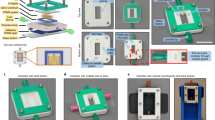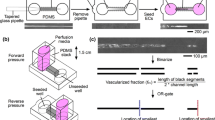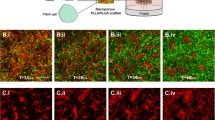Abstract
Morphogenesis is a fundamental process by which new blood vessels are formed during angiogenesis. The ability to control angiogenesis would lead to improvements in tissue engineering constructions; indeed, the study of angiogenesis has numerous clinical applications, for example, in the investigation of metastatic cancer, peripheral and coronary vascular disease, and wound healing. Conventional in vitro organotypic cell culture approaches to these studies are limited primarily by their reliance on microvascular vessel formation through a random process of morphogenesis that lacks the spatial reproducibility and orientation needed for high-throughput drug testing. We have developed a bioreactor system for scaffold-guided tubulogenesis coupled with 3-D organotypic culture to spatially control vessel formation and its orientation. To create microchannels to guide microvessel formation, we fabricated rigid scaffolds using photolithography and light curing epoxy, and soft scaffolds formed by a polydimethylsiloxane (PDMS) stamp directly into collagen. Scaffolds seeded with dermal microvascular endothelial cells were placed between gelled layers of collagen containing dermal fibroblasts within a Transwell filter system and cultured for up to 2 weeks to allow for vessel maturation. Morphological analysis of thin tissue sections following standard histology and immunohistochemical detection of endothelial cells, fibroblasts, and basement membrane confirmed vessel formation along the microchannel walls with either scaffold. This system may also provide a means to explore revascularization within decellularized extracellular matrices, the culture of microvessel networks with controlled geometries, and possibly the spatial guidance of angiogenesis for interfacing with an external microfluidic supply network. As a new tool for guided angiogenesis, our approach introduces new possibilities for identification of anti-angiogenic therapeutics.









Similar content being viewed by others
References
A.F. Black, F. Berthod, N. L’Heureux, FASEB J 12, 1331 (1998)
A.F. Black, V. Hudon, O. Damour, Cell Biol Toxicol 15, 81 (1999)
G.E. Davis, K.J. Bayless, A. Mavila, Anat Rec 268, 252 (2002)
D. Donovan, N.J. Brown, E.T. Bishop, Angiogenesis 4, 113 (2001)
N. Fournier, C.J. Doillon, Cell Biol Int Rep 16, 1251 (1992)
H. Geckil, F. Xu, X. Zhang, S. Moon, U. Demirci, Nanomedicine 5, 469 (2010)
W. He, Z.W. Ma, T. Yong, W.E. Teo, S. Ramakrishna, Biomaterials 26, 7606e15 (2005)
S. Kanzawa, H. Endo, N. Shioya, Ann Plast Surg 30, 244 (1993)
N. Koike, D. Fukumura, O. Gralla, Nature 428, 138 (2004)
A. Kurane, D.T. Simionescu, N.R. Vyavahare, Biomaterials 28, 2830 (2007)
T.J. Lawley, Y. Kubota, J Invest Dermatol 93, 59S (1989)
M. Martins-Green, Q.J. Li, M. Yao, FASEB J 19, 222 (2005)
H. Mertsching, T. Walles, M. Hofmann, Biomaterials 26, 6610 (2005)
V. Nehls, D. Drenckhahn, Histochem Cell Biol 104, 459 (1995)
L.E. Niklason, Science 286, 1493 (1999)
L.E. Niklason, J. Gao, W.M. Abbott, K.K. Hirschi, S. Houser, R. Marini, R. Langer, Science 284, 489 (1999)
L.L. Nguyen, P.A. D’Amor, Int Rev Cytol 204, 1 (2001)
T.H. Petersen, E.A. Calle, L. Zhao, E.J. Lee, L. Gui, M.B. Raredon, K. Gavrilov, T. Yi, Z.W. Zhuang, C. Breuer, E. Herzog, L.E. Niklason, Science 329, 538 (2010)
M. Radisic, M. Euloth, L. Yang, R. Langer, L.E. Freed, G. Vunjak-Novakovic, Biotechnol Bioeng 82, 403 (2003)
B. Vailhe, D. Vittet, J.J. Feige, Lab Invest 81, 439 (2001)
O.C. Velazquez, R. Snyder, Z.J. Liu, R.M. Fairman, M. Herlyn, The FASEB Journal 16, 1316 (2002)
R.B. Vernon, E.H. Sage, Microvasc Res 57, 118 (1999)
G. Vunjak-Novakovic, B. Obradovic, P. Bursac, I. Martin, R. Langer, L.E. Freed, Biotechnol Prog 14, 193 (1998)
N. Yamamura, R. Sudo, M. Ikeda, Tissue Eng 13, 1443 (2007)
E.K. Yim, I.C. Liao, K.W. Leong, Tissue Eng 13, 423 (2007)
Y. Zhu, Y. Cao, J. Pan, Y. Liu, J Biomed Mater Res Part B: Appl Biomater 92B, 508e16 (2010)
Acknowledgments
This research work was supported by the Department of Defense Breast Cancer Research Program Grant W81XWH-07-1-0507 and the Vanderbilt Institute for Integrative Biosystems Research and Education (VIIBRE). Yuxin Liu thanks the WVU EPSCoR program funded by the National Science Foundation (EPS-1003907) for its support of her work on the manuscript at WVU. We thank Allison Price for her editorial assistance.
Author information
Authors and Affiliations
Corresponding author
Rights and permissions
About this article
Cite this article
Liu, Y., Markov, D.A., Wikswo, J.P. et al. Microfabricated scaffold-guided endothelial morphogenesis in three-dimensional culture. Biomed Microdevices 13, 837–846 (2011). https://doi.org/10.1007/s10544-011-9554-2
Published:
Issue Date:
DOI: https://doi.org/10.1007/s10544-011-9554-2




